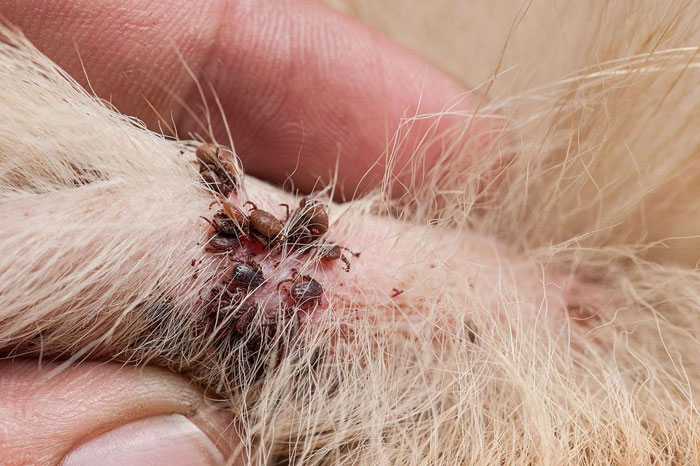Flea treatment for dogs: How to prevent

Fleas are blood-sucking external parasites. Once a dog becomes infested with fleas, it severely disrupts their normal life, making prompt flea treatment for dogs crucial. Fleas pose two primary hazards to dogs: First, fleas can transmit infectious diseases and parasitic infections. Second, fleas cause intense skin irritation, leading to severe itching. Dogs vigorously scratching can damage their skin and prevent them from resting properly, resulting in reduced appetite and weight loss. These issues require relief and resolution through scientifically sound flea treatment for dogs.
Pathogens and Life Cycle — Understanding the Basics to Enhance Flea Treatment for Dogs
Throughout their lifecycle, fleas spend most of their time off the dog’s body. Being light-sensitive, they typically hide in bedding materials or floor cracks, only parasitizing the dog when feeding or laying eggs. A single female flea can lay 100–200 eggs. Flea eggs are oval-shaped with pointed ends, white, and extremely small—difficult to see with the naked eye. As dogs move, these eggs can fall off, spreading throughout the dog’s living areas. The development from egg to adult flea takes approximately 21 days, though this period may lengthen in colder climates. Newly hatched fleas can survive for weeks without feeding, lying in wait for a dog. Understanding the flea life cycle helps us develop more precise flea treatment plans for dogs, improving treatment effectiveness.
Diagnostic Key Points — Accurate Assessment as the Foundation for Flea Treatment for Dogs
The primary clinical symptom is intense itching, serving as a key indicator for determining the need for flea treatment for dogs. Affected dogs exhibit scratching, rubbing, and biting of their fur, leading to hair loss, broken hairs, and abrasions. In severe cases, skin lesions may ooze fluid or develop into suppurating wounds. Allergic reactions may sometimes develop, leading to eczema. If these symptoms are observed, carefully examine the fur around the neck and base of the tail. During inspection, comb the fur against the grain to observe the hair roots and skin. The presence of fleas or flea feces confirms the diagnosis, necessitating prompt initiation of flea treatment for dogs. Alternatively, place a damp white sheet of paper beneath the dog and comb its fur. Flea droppings will continuously fall onto the paper, confirming the diagnosis and providing evidence for subsequent flea treatment for dogs.
Prevention and Control Measures — Scientific Implementation of Flea Treatment for Dogs and Prevention
Commercial flea powders and general insecticides can kill adult fleas, which is a common approach targeting adults in flea treatment for dogs. However, flea eggs possess strong resistance and are difficult to eliminate. Multiple applications are necessary, typically once weekly for over a month, This is the critical step to ensure thorough flea treatment for dogs. While eliminating fleas on the dog, it is essential to thoroughly disinfect the dog’s living areas, especially its belongings. This is an indispensable part of flea treatment for dogs, preventing fleas from reinfesting. Replace all bedding in the dog’s sleeping area, and incinerate the discarded items. Dogs with skin abrasions require wound debridement, disinfection, and infection prevention. These supportive measures complement flea treatment for dogs, aiding faster recovery. For dogs experiencing severe itching, injections of dexamethasone and diphenhydramine can alleviate discomfort, creating better conditions for flea treatment.
Maintaining good canine hygiene through regular bathing, frequent grooming, and ample sun exposure is an effective method to prevent flea infestations and reduce the need for flea treatment for dogs. Additionally, using flea collars is a good approach. They serve as a preventive measure after flea treatment for dogs and also provide protection before infection occurs. These collars contain flea-killing medication. Numerous tiny pores in the collar allow the medication to seep out, coating most of the dog’s body. Upon contact with fleas, the medication repels or kills them. However, note that prolonged use may cause skin allergies in some dogs. If allergic reactions occur, promptly adjust the flea treatment and prevention plan.
admin
-
Sale!

Washable Pet Cooling Pad for Cats and Dogs
$10.99Original price was: $10.99.$9.99Current price is: $9.99. This product has multiple variants. The options may be chosen on the product page -
Sale!

Washable Cat Window Hammock Cooling Bed
$23.99Original price was: $23.99.$22.99Current price is: $22.99. -
Sale!

Tropical Amphibian Rainforest Tank, Lizard Cage
$38.99Original price was: $38.99.$36.99Current price is: $36.99. -
Sale!

Silent 4-in-1 Waterproof Charging Dog Hair Trimmer
$49.88Original price was: $49.88.$47.99Current price is: $47.99.